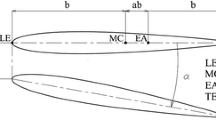Abstract
The inverse problem of wing aerodynamics—the determination of the lifting surface shape from a specified load—is solved within the framework of linear theory. Volterra's solution of the wave equation is used. Solutions are found in the class of bounded functions if certain conditions imposed on the governing parameters of the problem are satisfied. Solutions of inverse problems of supersonic flow are presented for an infinite-span wing, a triangular wing with completely subsonic edges, and a rectangular wing.
Similar content being viewed by others
References
N. F. Vorob'ev,Lifting-Surface Aerodynamics in a Steady Flow [in Russian], Nauka, Novosibirsk (1985).
W. R. Sears (ed.),General Theory of High-Speed Aerodynamics, Princeton Univ. Press, New Jersey (1957).
N. F. Vorob'ev, “An exact solution of the end-effect problem for a wing of finite span in a supersonic flow”,Prikl. Mekh. Tekh. Fiz.,33, No. 1, 65–71 (1992).
N. F. Vorob'ev, “Unique features of the aerodynamics problems for a wing of finite span”,Prikl. Mekh. Tekh. Fiz.,35, No. 3, 55–66 (1994).
Additional information
Institute of Theoretical and Applied Mechanics, Siberian Division, Russian Academy of Sciences, Novosibirsk 630090. Translated from Prikladnaya Mekhanika i Tekhnicheskaya Fizika, Vol. 39, No. 3, pp. 86–91, May–June, 1998.
Rights and permissions
About this article
Cite this article
Vorob'ev, N.F. Inverse problem of wing aerodynamics in a supersonic flow. J Appl Mech Tech Phys 39, 399–403 (1998). https://doi.org/10.1007/BF02468122
Received:
Issue Date:
DOI: https://doi.org/10.1007/BF02468122




